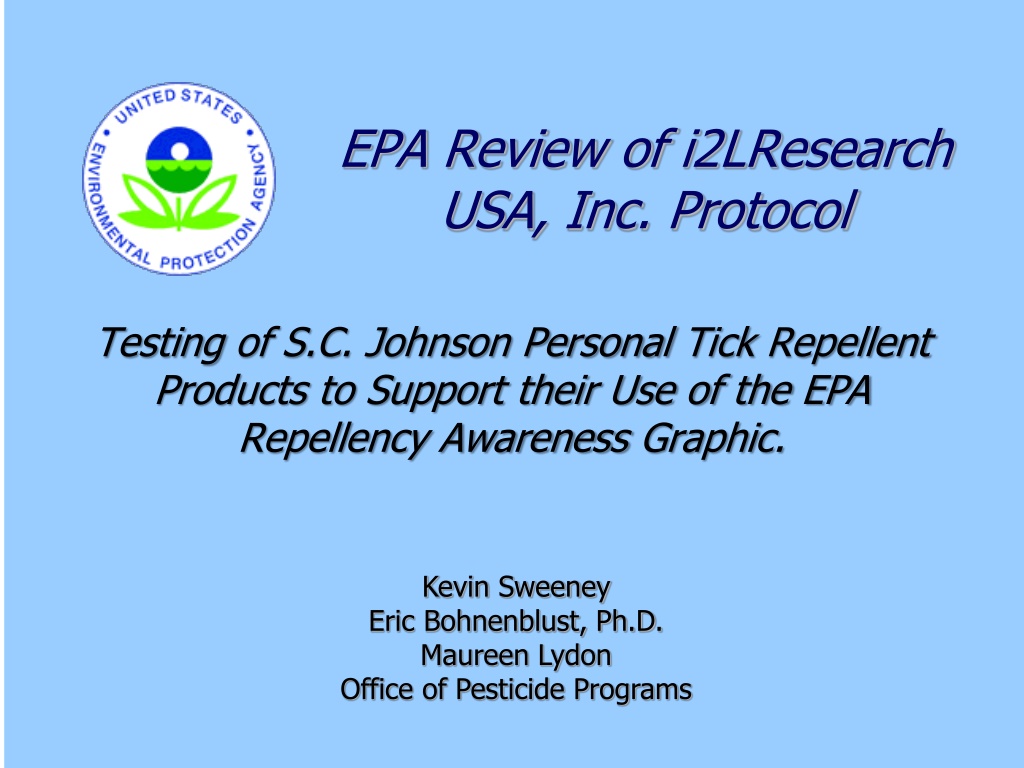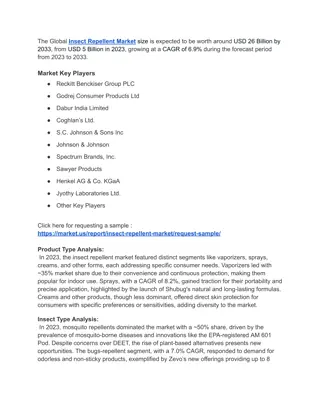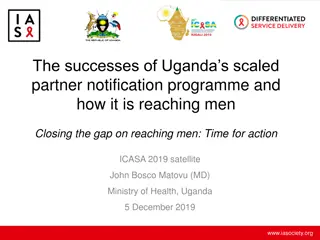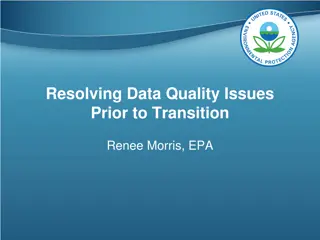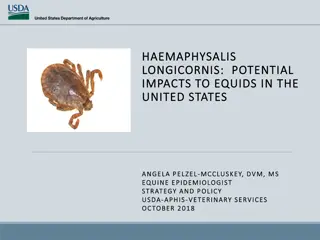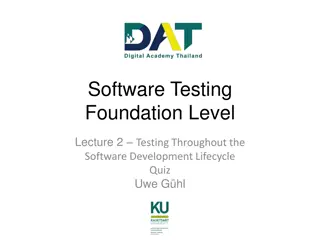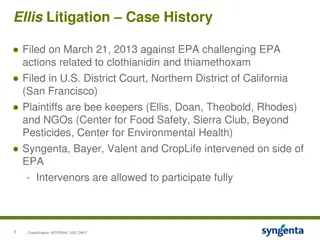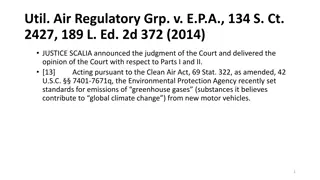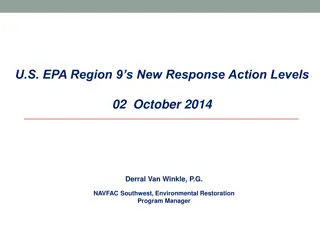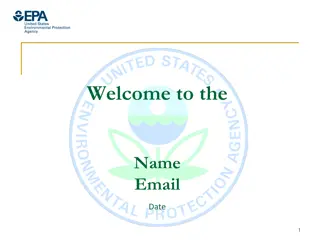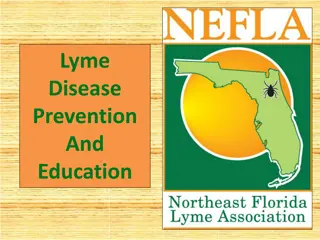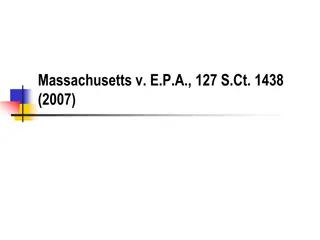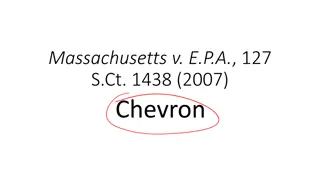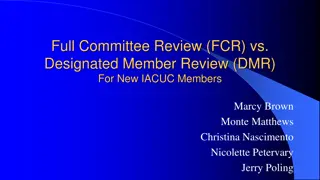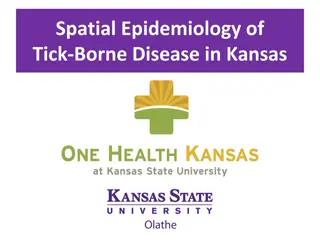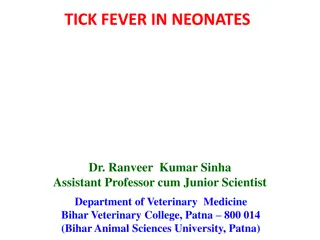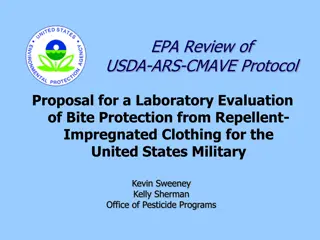EPA Review of Tick Repellent Testing Protocol
i2LResearch submitted a protocol for testing tick repellent products to determine the Complete Protection Time and support the use of the EPA Repellency Awareness Graphic. The testing will be conducted by i2L Research USA, Inc. in Baltimore, Maryland, against three tick species with human subjects. A comparison to existing skin-applied repellent protocols was also reviewed in the process. The Repellency Awareness Program aims to raise public awareness of the health protectiveness of skin-applied insect repellents. The EPA Repellency Awareness Graphic informs consumers about the duration of repellent protection for informed product choices.
Download Presentation

Please find below an Image/Link to download the presentation.
The content on the website is provided AS IS for your information and personal use only. It may not be sold, licensed, or shared on other websites without obtaining consent from the author.If you encounter any issues during the download, it is possible that the publisher has removed the file from their server.
You are allowed to download the files provided on this website for personal or commercial use, subject to the condition that they are used lawfully. All files are the property of their respective owners.
The content on the website is provided AS IS for your information and personal use only. It may not be sold, licensed, or shared on other websites without obtaining consent from the author.
E N D
Presentation Transcript
EPA Review of i2LResearch USA, Inc. Protocol Testing of S.C. Johnson Personal Tick Repellent Products to Support their Use of the EPA Repellency Awareness Graphic. Kevin Sweeney Eric Bohnenblust, Ph.D. Maureen Lydon Office of Pesticide Programs 1
Overview i2LResearch submitted a protocol for testing insect repellent products against ticks in the laboratory to determine the Complete Protection Time (CPT) of their 18 skin applied repellent products to support the use of the EPA Repellency Awareness Graphic. 2
Overview (2) Testing will be conducted by i2L Research USA, Inc. in Baltimore, Maryland. Testing will be conducted against 3 tick species with up to 30 different human subjects per product (10 per species). 3
Comparisons to Skin-Applied Repellent Protocols Reviewed by the HSRB In this protocol: Aerosol and lotion products are proposed to be tested at 1 g/600cm2 Spritz/pump sprays are proposed to be tested at 0.5 g/600cm2 A dosimetry phase is not proposed. This is a departure from the design of repellent efficacy studies that that have been reviewed and approved by EPA and the HSRB in recent years, which have experimentally determined the dose. 4
What is the Repellency Awareness Program? A program to raise public awareness of the health protectiveness of mosquito and tick repellents applied to the skin. Purposes: Raise consumer awareness of the efficacy of skin- applied insect repellents. Increase EPA and consumer confidence in the efficacy claims on labels. Improve consumer protection against vector borne diseases, such as Lyme disease and West Nile virus.
Repellency Awareness Graphic The graphic clearly informs consumers about the duration of repellent protection so that they can make informed choices about the repellent products they purchase and use. 7
Science Assessment: Testing of S.C. Johnson Personal Tick Repellent Products to Support their Use of the EPA Repellency Awareness Graphic Kevin Sweeney Eric Bohnenblust, Ph.D. Registration Division Office of Pesticide Programs 8
Study Objectives To determine the complete protection time (CPT) of up to eighteen EPA registered skin applied repellent products from S.C. Johnson & Son, Inc. in the laboratory against adults of 3 tick species using volunteer human subjects to support use of the EPA Repellency Awareness Graphic on the product label. 9
Study Objectives (2) The data provided from this research can be used by the EPA to support the addition of the Repellency Awareness Graphic to skin applied insect repellent labels, thereby allowing for better protection of consumers from nuisance arthropod bites and bites that lead to arthropod-borne diseases. 10
Acute Toxicity of the Test Materials All test materials are S.C. Johnson Products registered by the EPA as skin applied insect repellents. Acute Dermal LD50 >2,000 mg/kg body weight Minimally irritating to the skin and eyes. Not skin sensitizers. 11
Margin of Exposure (MOE) Estimate S.C. Johnson prepared an estimate of the Margin of Exposure via the dermal route for each of the 18 products to be tested. The proposed exposures to the subjects in these tests are not of concern for the three active ingredients to be tested. 12
Calculated Margins of Exposure for DEET Products Table 1: Acute3 Active Ingredient LD50 Acute Product2 LD50 (mg/kg) Adj. Acute Product6 LD50 (mg/kg) Adj. MOE6 MOE4 Dose (mg)1 Product MOE (mg/kg) 4280 5% DEET Spritz (4822-415) 567 >2,000 >282 5000 >705 >8161 5.6% DEET Towelette (4822-552) 1133 >2,000 >141 5000 >353 4280 >3645 7% DEET Spritz (4822-395) 567 >2,000 >282 5000 >705 4280 >5829 15% DEET Aerosol (4822-380) 1133 >2,000 >141 5000 >353 4280 >1361 15% DEET Aerosol (4822-543) 1133 >2,000 >141 5000 >353 4280 >1361 25% DEET Aerosol (4822-167) 1133 >2,000 >141 5000 >353 4280 >817 25% DEET Towelette (4822-258) 1133 >5,000 >353 4280 >817 25% DEET Spritz (4822-399) 567 >5,000 >705 4280 >1632 25% DEET Aerosol (4822-572) 1133 >5,000 >353 4280 >817 30% DEET Aerosol (4822-397) 1133 >5,000 >353 4280 >680 98.25% DEET Spritz (4822-276) 567 4280 >615 13
Calculated Margins of Exposure for Picaridin Products Table 2: Acute Product2 LD50 (mg/kg) Acute Active LD50 (mg/kg)3 Dose1 (mg) Product MOE MOE Acute Produ ct LD02 (mg/kg) >5,020 5% Picaridin Spritz (4822-536) 567 >5,020 >708 >2000 >24974 Acute Active LD03 (mg/kg) >2000 Dose1 (mg) 1133 Product MOE MOE >2000 5% Picaridin Lotion (4822-535) 1133 >5,040 >356 >2824 354 5% Picaridin Spritz (4822- 536) 5% Picaridin Lotion (4822- 535) 20% Picaridin Spritz(4822- 556) 20% Picaridin Aerosol (4822-564 12494 1133 >5,040 >5,020 356 >2000 >708 2824 >2000 20% Picaridin Spritz(4822-556) 567 >6244 1133 >5,020 354 >2000 3124 1133 >5,020 >5,020 354 >2000 >354 3124 >2000 20% Picaridin Aerosol (4822-564) 1133 >3124 14
Calculated Margins of Exposure for p-Methane-3, 8-Diol (PMD) Products Table 3: Acute Product2 LD50 Acute Active3 LD50 Product Dose1 (mg) MOE4 MOE (mg/kg) (mg/kg) 1133 >5,000 >353 >5000 >4413 8% PMD Towelette(4822- 526) 10% PMD Lotion (4822-515) 1133 >5,000 >353 >5000 >3529 10% PMD Spritz(4822-528) 567 >5,000 >705 >5000 >7055 15
Dosage and Product Application i2LResearch will not include a dosimetry phase to determine typical consumer dose. Instead, i2LResearch proposes standardized rates of: 1 g/600cm2 for aerosol and lotion products 0.5 g/600cm2 for Spritz/pump sprays 16
Dosage and Product Application (2) A set dose can be related to known consumer behavior based on past tests reviewed by the HSRB where dosimetry was employed for skin applied insect repellent products. 17
Dosage and Product Application (3) The HSRB determined during their April meeting that a dose of 1 g/600cm2 was appropriate for all product types. However, based on analysis of dosimetry results from repellent studies reviewed since 2006, EPA recommends the following doses be used for studies conducted using this protocol: Aerosol/lotion 1 g/600cm2 Towelette/pump spray 0.5g/600cm2 Data may be bridged from a pump spray to a towelette because pump spray and towelette formulations are usually similar and the pump spray is applied at a lower dose. 18
Experimental Design For each test, 10 subjects (5 males and 5 females) will be treated with the test substance. Two additional subjects (one male and one female) will serve as alternates for each test. The test subjects will be selected at random from a pool of potential subjects from the area around Baltimore, MD. 19
Experimental Design (2) For each product there will be a total of up to 30 different treated subjects and up to 6 different alternate subjects. The subjects will not be blinded to the test substances with which they are treated. If subjects participate in more than 1 test, the tests must be separated by a minimum of 2 days. Subjects are required to wash after each test. A positive control substance will not be used. 20
Experimental Design (3) Each subject will have one forearm treated with the repellent product to be tested, and the other arm will serve as the untreated control. Assignment of the test substance to the subject s arms will be randomized. The control arm will be used to qualify ticks that are active, and determine the attractiveness of the subject to ticks. The data collected from the control arm will not be used to calculate the Median Complete Protection Time. 21
Experimental Design (4) Four lines will be drawn on both of the subjects forearms as follows: Release line 3 cm above the wrist bone towards the elbow Boundary line 3 cm above the release line towards the elbow (this will be the edge of the treated area) Crossing line 3 cm above the boundary line An upper boundary line 12 cm above the boundary line; this will not be used during testing and serves only to denote the boundary of the treated area. 22
Experimental Design (5) Crossing line Boundary line Upper boundary Release line 23
Boundary line Upper boundary Release line Crossing line 24
Experimental Design (6) Ticks will be trialed to make sure they will actively quest. To qualify this behavior, ticks will be placed at the release line on the untreated control arm and then must cross the boundary line within 3 min. Treatments will be challenged with 1 tick every 15 minutes (4 ticks/h). 25
Experimental Design (7) Once qualified, the ticks will be placed at the release line on the treated arm. After the tick begins to move up the arm, it will be given 3 minutes to cross the boundary and crossing lines on the treated arm. Ticks are considered repelled if in 3 min. they do not: Reach the boundary line Reach the crossing line Ticks are considered not repelled if in 3 min. they reach the crossing line. 26
Experimental Design (8) DEET Products Maximum Number of Tick Exposures per Species /Product Test (18 hours) 72/206 Repellent Product EPA Reg. No. Product Type Total Replicates per Product Number of Human Subjects per Tick Species (Replicates) 10 Number of Tick Species 4822-415 5% DEET Spritz 3 30 4822-552 4822-395 4822-380 4822-543 5.6% DEET Towelette 7% DEET Spritz 15% DEET Aerosol 15% DEET Aerosol 3 3 3 3 10 10 10 10 30 30 30 30 72/206 72/206 72/206 72/206 4822-167 25% DEET Aerosol 3 10 30 72/206 4822-258 25% DEET Towelette 3 10 30 72/206 4822-399 25% DEET Spritz 3 10 30 72/206 4822-572 25% DEET Aerosol 3 10 30 72/206 4822-397 30% DEET Aerosol 3 10 30 72/206 4822-276 98.25% DEET Spritz 3 10 30 72/206 27
Experimental Design (9) Picaridin Products Maximum Number of Tick Exposures per Species /Product Test (18 hours) 72/206 Repellent Product Number of Human Subjects per Tick Species (Replicates) 10 Total Replicates per Product 30 Number of Tick Species 3 EPA Reg. No. Product Type 4822-536 5% Picaridin Spritz 4822-535 5% Picaridin Lotion 3 10 30 72/206 4822-556 20% Picaridin Spritz 4822-564 20% Picaridin Aerosol 3 10 30 72/206 3 10 30 72/206 28
Experimental Design (10) PMD Products Maximum Number of Tick Exposures Per Species/Product Test (18 hours) 72/206 72/206 72/206 Number of Human Subjects per Tick Species (Replicates) 10 10 10 Total Replicates per Product 30 30 30 Repellent Product Number of Tick Species 3 3 3 EPA Reg. No. Product Type 4822-526 8% PMD Towelette 4822-515 10% PMD Lotion 4822-528 10% PMD Spritz 29
Endpoints and Measures Unit of measure for determination of the repellent effects is Complete Protection Time (CPT). The CPT for each tick species will be calculated as the time from test substance application to the time of the First Confirmed Crossing. The time in hours for each individual test subject will be used to calculate the median protection time for each species separately. 30
Endpoints and Measures (2) A Crossing occurs when a tick crosses the crossing line within 3 min. on the treated arm of a subject. A First Confirmed Crossing is that which is followed by the subsequent tick crossing in the next exposure period, or the first subsequent tick is repelled but the second subsequent tick is recorded as not being repelled. 31
Statistical Analysis Plan The objective of the data analysis is to estimate the Median Complete Protection Time. The Median CPT of all test subjects will be calculated using the Kaplan-Meier Survival Analysis, which is advantageous since CPTs may not be normally distributed. 32
Statistical Analysis Plan (2) As evidenced by the table, sample sizes larger than ten would provide only marginal increases in precision relative to the increase in the number of exposed test subjects. Table 1:Kaplan-Meier Median Confidence Limits for a Range of Sample Sizes. Distributional position for 95% LCL Distributional position for 95% UCL Percent of values above LCL Sample size 10 1 8 90% 12 2 10 83% 15 3 11 80% 33 20 5 15 75%
Statistical Analysis Plan (3) The Kaplan-Meier Survival Analysis has been accepted by EPA and the HSRB for the Median CPT calculation in past efficacy studies using repellents and is also recommended by the World Health Organization for CPT calculation from these data sets. 34
Statistical Analysis Plan (4) The proposed sample size of 10 subjects per study represents a reasonable compromise between increasing precision and limiting costs based on past analyses by the EPA. 35
Measures to Ensure Reliability Good Laboratory Practices, as defined by 40 CFR part 160 will be followed throughout all studies. Study staff will conduct a training session with the subjects on a day prior to the test date. Study staff will treat the skin of the exposed limb with the test substance and the limb will be measured in advance. Study staff will place ticks on the untreated and treated arms. Study staff will monitor and record tick movement and the start and stop times for each exposure period. Study staff and the study director will track test substance samples, closely monitor the testing, and data recording. Alternate subjects will be enrolled to ensure adequate sample size. A Quality Assurance Unit will be in place to monitor all study activities and data collection. Test subjects can only take part once in any two-day testing period. If scheduled to participate in two studies within one week, there will be two calendar days in between test days. 36
Compliance with Scientific Standards The following elements are adequately addressed: Available toxicity studies with DEET, picaridin, and PMD. Adequately characterize toxicological profile of the formulations. Data to support estimate of acceptable Margin of Exposure (MOE). 37
Compliance with Scientific Standards The following elements are generally acceptable but require refinement and clarification: Pre-Training Experimental Design Data Analysis 38
Science Comments and Recommendations 1 1) EPA comment: Pre-training of subjects is barely described. More information is required. The protocol should be explicit with regard to the training outline and specific topics to be addressed. S.C. Johnson & i2L response: Revised section 2.2.5 with an outline providing specifics for pre-training. 39
Science Comments and Recommendations 2 2) EPA comment: Please provide more details on the exact timing of the testing. The protocol needs to explicitly describe the amount of time the technician has to do testing and the amount of time in a 15 minute period that requires the subject to be seated and exposed to ticks. S.C. Johnson & i2L Research response: Revised protocol to include specific details regarding testing. 40
Science Comments and Recommendations 3 3) EPA comment: Repellent sample size selection: The protocol cites one example of the effect of sample size on mean confidence interval width when changed from 10 to 20 subjects. Submit a simulation showing the impact of increasing sample size on the width of 95% confidence interval of median CPT where median CPT will be estimated using Kaplan Meier method. This can be presented in table form. 41
Science Comments and Recommendations 3 continued S. C. Johnson & i2L Research response: Sample size is adequate and is unlikely to overestimate CPT due to selection of the lowest CPT value, and historical precedent. 42
Science Comments and Recommendations 3 continued S. C. Johnson & i2L Research response continued: The confidence limits associated with the Kaplan-Meier median are positional values in the distribution, rather than calculated values as in the case of a confidence interval around the mean. 43
Science Comments and Recommendations 3 continued S.C. Johnson & i2L Research response continued: The table from slide 32 indicates which positions in the distribution of values constitute the lower confidence limit (LCL) and upper confidence limit (UCL) of the median for various sample sizes. The assumption is that the values are sorted in increasing order, so value 1 in the distribution refers to the smallest value (i.e., the minimum). 44
Science Comments and Recommendations 4 4) EPA Comment: A randomization mechanism needs to be inserted into sections 2.3.8 and 2.3.9. S.C. Johnson & i2L Research response: Will use a random number generator from a statistical software package (e.g., Minitab, Excel) 45
Science Comments and Recommendations 5 5) EPA Comment: Amend the protocol to require subjects to wait at least two calendar days (48 hours) between tests if they participate in multiple tests. S.C. Johnson & i2L Research response: Amended the protocol to require subjects wait two days between participating in different tests 46
Compliance with Scientific Standards As amended to address the concerns raised in the EPA review, the i2L Research USA protocol entitled Testing of S.C. Johnson Personal Tick Repellent Products to Support their Use of the EPA Repellency Awareness Graphic is likely to yield scientifically reliable information, satisfying the following scientific criteria from the framework recommended by the HSRB: It would produce important information that cannot be obtained except from research with human subjects. It has clear scientific objectives. The study design should produce adequate data to achieve those objectives. 47
Ethics Assessment: Testing of S.C. Johnson Personal Tick Repellent Products to Support their use of the EPA Repellency Awareness Graphic Maureen Lydon Office of the Director Office of Pesticide Programs 48
Value to Society Proposed study will determine the complete protection time (CPT) of up to 18 EPA-registered insect repellent products against ticks Up to 3 different active ingredients (AIs) and variety of products, all previously registered and assessed by EPA, will be tested for duration of efficacy Product-specific efficacy testing is required to support use of EPA s Repellency Awareness Graphic on product labels. 49
Value to Society 2 Consumers who use tick repellents to avoid tick bites cannot readily assess the duration of repellency. If EPA s Repellency Awareness Graphic is added to the label, consumers can make informed decisions by knowing the length of time each product repels ticks. 50
